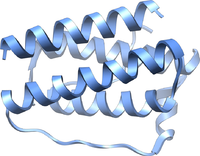
Photo from wikipedia
Myotis nigricans is a species of bat from the Vespertilionidae family that is endemic of the Neotropical region. Its insectivorous feeding habit plus its large range of prey species, great… Click to show full abstract
Myotis nigricans is a species of bat from the Vespertilionidae family that is endemic of the Neotropical region. Its insectivorous feeding habit plus its large range of prey species, great geographical dispersion, wide colonies, and anthropomorphized behavior make this species an important ecological agent that acts in the control of nocturnal insects. Reproductively, M. nigricans presents geographic variations, having different patterns of reproduction according to its geographical location. Despite these extremely interesting characteristics, no more detailed study of the hormonal control of the reproduction of this species has been conducted. Therefore, the aim of the present study was to evaluate the variations in serum hormone concentrations and in uterine hormonal control of this bat during its different reproductive phases. Twenty adult females were collected, divided into four (4) sample groups, according to the reproductive status (nonreproductive, initial, and advanced pregnancy and lactating), and submitted to hormone dosage and immunohistochemical analyses. The results demonstrated that the uterus of M. nigricans is strongly regulated by the interaction/cross-talk between serum concentrations of estradiol (E2) and progesterone with their respective hormone receptors. Significant increases in the concentration of E2 and progesterone are needed to regulate the early pregnancy. The persistence of the corpus luteum throughout pregnancy is necessary, since its placenta does not express aromatase. The expressions of ERα and PR appear to be synchronized in order to coordinate a large portion of the processes that occur inside the uterus of M. nigricans during pregnancy and lactation.
Journal Title: Cell and Tissue Research
Year Published: 2021
Link to full text (if available)
Share on Social Media: Sign Up to like & get
recommendations!